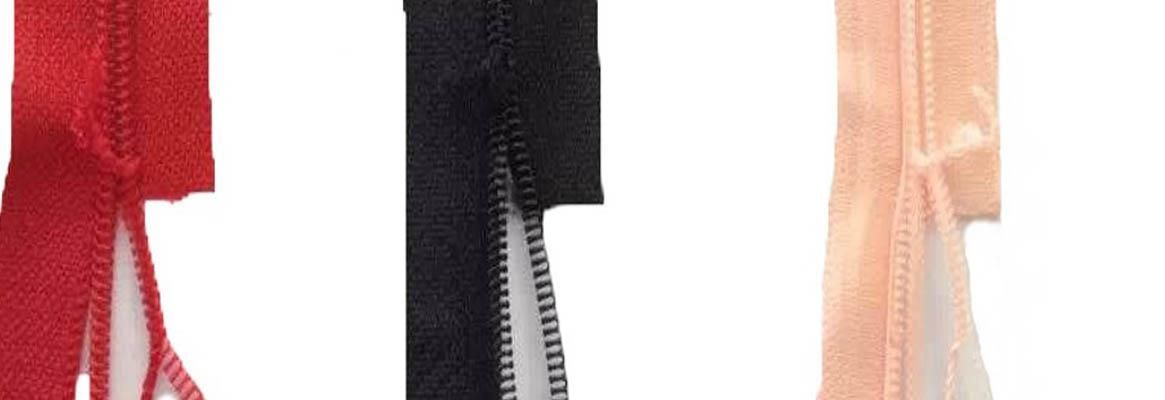The teeth of the coil zippers are made of monofilament polyesters. These zippers are applicable for various segments in the market ranging from apparel industry such as manufacturing of pants, jackets, kidswear and coats to the production of furniture, seat covers, tents and many more.
As a coil zipper supplier, SBS Zipper supplies 3 different types of coil zippers.
1. Coil zipper without cord: Its teeth are made of monofilament and create a hollow spiral.
2. Coil zipper with cord: Its teeth are also made of monofilament which centres round the centre-cord and then form a spiral.
3. Invisible zipper: The formation its teeth are similar to that of the coil zipper with cord but they are covered by the zipper tape while zipping it up, which makes them invisible on the front end.
How to install coil zippers?
During the tooth cutting process, some portion of the teeth on the zipper tape would be cut off. But half surplus tooth close to the top stop would be there for the zipper usage.
If the gap between the forth head tape where it is folded and then bent and the top stop located on the upper portion of the zipper is too close in the installation process, then the surplus half tooth introduced by the tooth-cutting process may be exposed. This in turn may harm the consumer. Thus the distance between the forth head tape and the first tooth should be minimum 5cm. The coil zipper with plastic top/bottom stops or U-type top stop should be used to avoid such problem.
Special care is needed while installing the invisible zippers. Take their attachment to the clothing that involves splicing for example. This splicing gets thick while the fabric is folded and if the sewing quality is bad then the sliding track of the zipper would get narrow. This would make it difficult to open and close the zipper, leading to damaging the tape while pulling the zipper forcefully. Thus the distance between the splicing section and zipper chain should be more than 2cm when the invisible zipper is used.
Usage of coil zippers
1. Rubberizing waterproof coil zippers
A layer of TPU film is attached to its tape that serves a purpose of water-repellent one. The side of the zipper where the film is attached would appear dark compared to the other side. However, this is not the waterproof zipper as water may leak through the gap in the zipper tape.
Below are the tips for using this type of zipper to avoid unanticipated hurdles and for better performance of the products they are attached to.
Zipper up the zipper completely while washing the garment and dry them naturally in proper ventilated place in order to avert the film from getting damaged.
-
Try to avoid dry cleaning solvent containing chlorine as that may affect the proper usage of the zipper. This may blanch the film and fade the colour of the zipper. It is preferable to use petroleum-based dry cleaning solvent.
-
Do not iron the zipper directly as the high temperature reaching to 150oC might affect the film, causing it to melt or bubble.
-
Folding and bending of the zipper frequently may blanch the film but this will not affect its water repellency performance.
-
Continuous contact with PVC and polyurethane will lead to dye transfer.
2. Coating coil zippers
There is a layer of aluminum attached to its teeth via vacuum planting. This is then followed by colouring and oil sealing applied to the teeth surface. Since the front teeth are coloured, these zippers are more used for the decorative purpose.
Below are the tips for using this type of zipper for longer service life and better perfomance.
-
Since the inner cavities of these sliders are tough as well as rough, they should not be paired with electroplated sliders. This might affect the coating layer of the surface. Thus it is wise to use spray painted and electrophoresis sliders.
-
Avert direct contact between the cleaning agents such as DJW, laundry detergents and zipper teeth as it may peel off the colour film from the surface of the teeth.
-
Do not use packaging products soon after the ironing is done, allow them to dry completely. The plastic bags used for packaging purpose should be breathable in order to protect the coating layer from oxidation, as this can lead to decolorisation and corrosion which may peel off the layer.
Purchasing tips
There are too many coil zipper suppliers in the market. There are certain aspects to be taken into consideration before placing an order with SBS zipper.
Following are some of the purchasing tips to be noted while buying the zipper.
-
The performance of the zipper completely depends on its end use. Despite its multi purpose usage ranging from larger leather products to the smaller ones such as shoes, boots, luggage to that of ski suits, tents, raincoats; zipper must withstand the product.
-
Usage of special techniques such as washing technique, stone/acid wash enzyme techniques, salt spray testing, exposure to high-temperature etc. must be made very clear if there are any post treatment involved after the installation process of the zipper.
-
Component of the product must be mentioned clearly if the zipper should be nickle free, lead free, azo free or should go through needle detection process.
Image courtesy:
1. SBS zipper
References:
1. SBS zipper.com
2. Threadsmagazine.com










Comments